AMD Kaveri Review: A8-7600 and A10-7850K Tested
by Ian Cutress & Rahul Garg on January 14, 2014 8:00 AM ESTCPU Performance
I often make a big song and dance about real world benchmarks being the main focus of a reviewer. Synthetics often stress parts of the CPU and distort advantages that a CPU might have and thus not affect you or me in the same manner when using the machine normally. For 2014 I have updated my usual benchmarking set, to include more video encoding and an image converter that takes 2D images and performs algorithms to convert the data into a 3D model. Some 2013 benchmarks are still here, showing what can be done, and to bring parity to previous CPU reviews, some synthetics are also included.
Agisoft Photoscan v1.0 - link
Our new main benchmark to AnandTech is provided by Agisoft. Their Photoscan software creates 3D models from 2D images, a process which is very computationally expensive. The algorithm is split into four distinct phases, and different phases of the model reconstruction require either fast memory, fast IPC, more cores, or even OpenCL compute devices to hand. Agisoft supplied us with a special version of the software to script the process, where we take 50 images of a stately home and convert it into a medium quality model. This benchmark typically takes around 15-20 minutes on a high end PC on the CPU alone, with GPUs reducing the time.
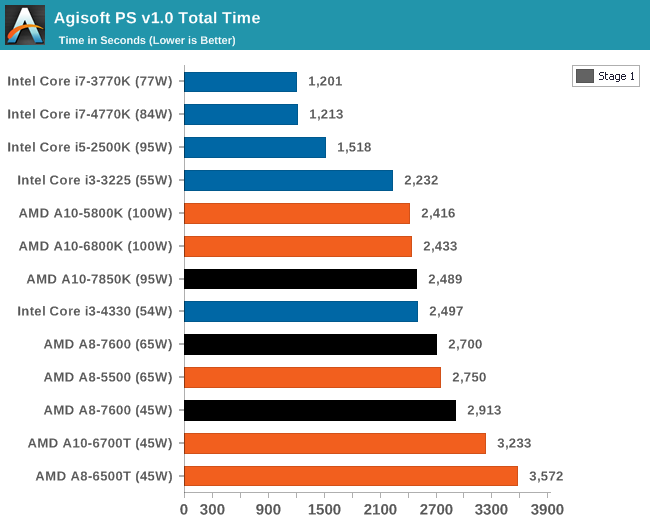
AMD suffers in overall time due to the lack of full-blooded cores and the reliance on single threaded performance in certain parts of the algorithm.
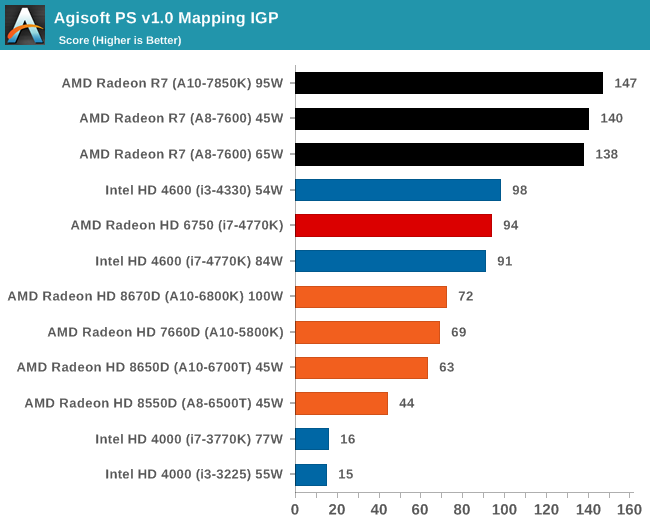
The second stage of the benchmark can be accelerated by the IGP of an APU, and as a result we can see the power of the high end APUs for this work can outshine any CPU we tested today. This is really the promise of HSA, it's just going to take a while to get there for most apps.
3D Particle Movement - link
3DPM is a self-penned benchmark, taking basic 3D movement algorithms used in Brownian Motion simulations and testing them for speed. High floating point performance, MHz and IPC wins in the single thread version, whereas the multithread version has to handle the threads and loves more cores.
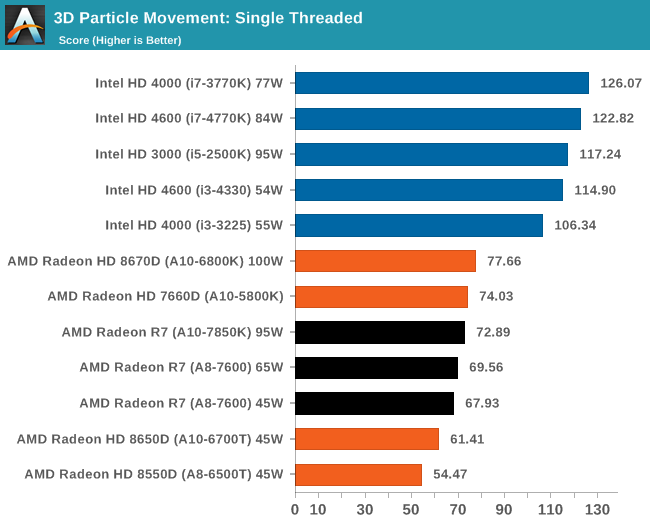
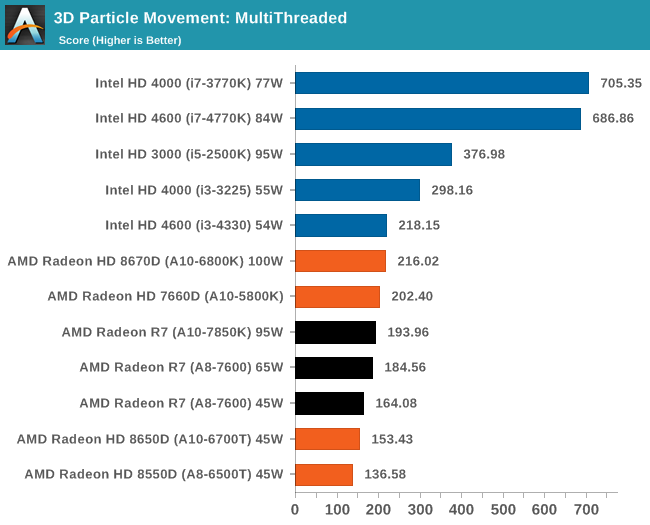
AMD is still suffering a lack of FP performance in our 3DPM benchmark.
WinRAR 5.01 - link
Our WinRAR test from 2013 is updated to the latest version of WinRAR at the start of 2014. We compress a set of 2867 files across 320 folders totaling 1.52 GB in size – 95% of these files are small typical website files, and the rest (90% of the size) are small 30 second 720p videos.
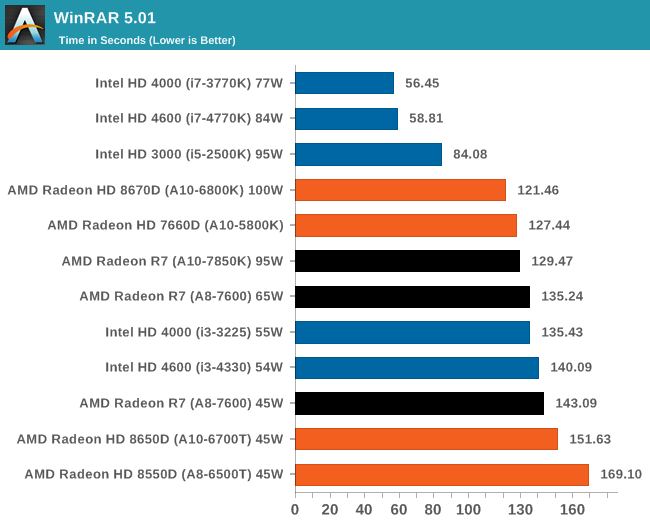
WinRAR loves IPC from the high end Intel chips, but even against the older i5-2500K there is still a deficit. The 45W Kaveri APU however is within fighting distance of its main rival.
FastStone Image Viewer 4.9 - link
Similarly to WinRAR, the FastStone test us updated for 2014 to the latest version. FastStone is the program I use to perform quick or bulk actions on images, such as resizing, adjusting for color and cropping. In our test we take a series of 170 images in various sizes and formats and convert them all into 640x480 .gif files, maintaining the aspect ratio. FastStone does not use multithreading for this test, and thus single threaded performance is often the winner.
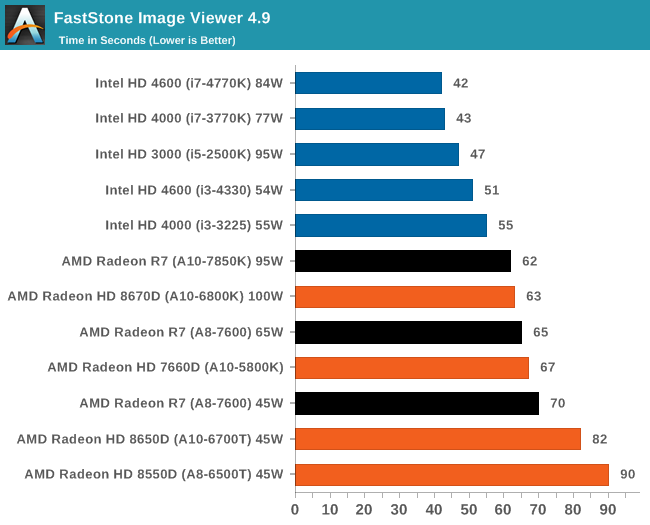
FastStone wants single threaded performance, so Intel wins here again.










380 Comments
View All Comments
jasonelmore - Tuesday, January 14, 2014 - link
I really wish these were launching in BGA GDDR5 Laptop/Mini ITX Packages.jaydee - Tuesday, January 14, 2014 - link
Pretty much what I was thinking as well. There are two mini-ITX FM2+ motherboards available on newegg, niether are "thin", and neither have DisplayPort. AMD's opportunity here is to market it's 45W Kaveri as the best CPU/GPU for the price in a small package. They NEED to get outside of the typical ATX, micro-ATX, mini-ATX box and into SFF, have all the ports that everyone wants, be creative with packaging and configurations (like GDDR5). They will never win a war with Intel in the traditional form-factor PCs, which is a rapidly shrinking market anyways.takeship - Tuesday, January 14, 2014 - link
Agreed. Any build not restricted to half height GPUs is better off going with a cheap intel cpu & discrete card. AMD really should be targeting ultra SFF type builds where Iris Pro is thermally limited, and a dGPU isn't an option.rhx123 - Tuesday, January 14, 2014 - link
GDDR5 7750's are available half height and at a decent price point, so even in a Low Profile machine a cheap Intel + 7750 is a better option. That's what I'm running anyway. Passively cooled i3 never reaches above 65c and the Saphire 7750 Low Profile is pretty quiet at idle.Mopar63 - Tuesday, January 14, 2014 - link
The last paragraph of this article shows someone that GETS IT, where Kaveri and the APU design in general is heading.nissangtr786 - Tuesday, January 14, 2014 - link
I can't believe how right I was, I was saying i3 4130 cpu performance and 2400-2500 3dmark11 gpu performance similar to my gt650m in my laptop. Funnily enough my laptop with i5 3210m at 2.9ghz gt650m with screen takes 87w, if I had an i3 4130 it would take about 92w lets say so it is about right. I am more shocked how spot on I was.HammerStrike - Tuesday, January 14, 2014 - link
The entire Anand reader base congratulates you on your deep insight and prophetic powers of deduction.nathanddrews - Tuesday, January 14, 2014 - link
I, for one, welcome our new nissangtr786 overlord.Zorba - Tuesday, January 14, 2014 - link
It would have been nice to see some non-integrated chips added to the benchmarks like an FX-6300. Ever since the APUs came out, it seems no reviews actually compare high-end iGPU vs moderate dGPU and CPU. Looking at the price, you could get a decent CPU+GPU for the cost of the A10-7850K, so it would be nice to see that as an option.R3MF - Tuesday, January 14, 2014 - link
"do any AnandTech readers have an interest in an even higher end APU with substantially more graphics horsepower?"Yes, and No.
I do want a higher-end APU, but I'd like to see one with four CPU modules and 256 shaders:
47% of the kaveri die space is GPU
http://www.extremetech.com/wp-conten...d-to-intel....
If you consider that roughly 20% is uncore, that leaves roughly 33% as CPU.
Give or take, 8 shader cores is fifty percent larger than 4 cpu cores.
You could double that cpu portion to 66%, and still leave 14% for shader cores.
Make the total die size just 10% bigger and you have an 8 cpu core APU with 4 HSA enabled shader cores ready to grind through FPU work. pretty much die-size neutral.